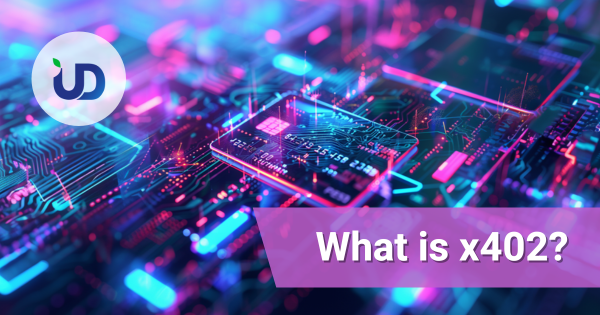What Is x402? The New Web3 Payment Protocol That Could Change How We Pay Online
If you’ve ever paid for an app, subscribed to an API, or bought digital content online, you know how messy payments can get — monthly subscriptions, card fees, region restrictions, endless sign-ups.
Now imagine a world where you only pay for what you actually use, directly from your crypto wallet, and access the content instantly. No registration, no card forms, no middlemen.
That’s exactly what x402 promises — a simple, decentralized, “pay-per-use” internet powered by blockchain.
In this article, we’ll explain what x402 is, how it works, and why it matters for the future of blockchain, AI, and Web3.
What Is X402?
x402 is a new open-standard payment protocol developed by Coinbase.
It’s based on an old but rarely used web feature — the HTTP status code 402: “Payment Required.”
Originally defined decades ago, HTTP 402 was meant for online payments, but it was never widely adopted — until now.
Coinbase’s x402 brings this idea to life by allowing websites, APIs, and AI agents to request payments directly over the standard internet protocol (HTTP).
In simple terms:
When you request something online, the server can respond, “This content costs $0.01 — pay first.” Once you pay using your crypto wallet (like USDC), access is instantly granted.
No sign-ups. No subscriptions. Just native, blockchain-powered payments built into the web itself.
How Does x402 Work? (Explained Step-by-Step)
Let’s walk through a simple example to understand how x402 functions.
1. You request a digital resource (for example, a dataset or an AI model output).
2. The server replies with a 402 Payment Required message, telling you:
- how much to pay,
- where to send the payment (the wallet address), and
- what token is accepted (e.g., USDC on Base or Ethereum).
3. You send the payment using your wallet or an automated agent.
4. After the blockchain confirms the payment, you re-request the same resource — but this time, you include your payment proof (such as an X-Payment header).
5. The server verifies that the payment was received and delivers the resource.
This whole process can take seconds, not minutes — perfect for microtransactions or automated AI-to-AI interactions.
Why Do We Need x402?
Traditional online payments were built for people, not for machines.
But the future of the internet is shifting toward autonomous services, AI agents, and on-demand resources.
For example:
- An AI assistant could pay $0.05 to access a premium language model.
- A web app could charge per API call instead of requiring monthly subscriptions.
- A data provider could sell access to a single dataset for $1.
x402 enables all of these possibilities by allowing instant crypto micropayments over standard web protocols.
Key Features of x402
1. Micropayments Support: Enables transactions as small as a few cents — ideal for per-use models.
2. No Sign-Up Needed: Users or AI agents can pay directly from their wallet — no registration or KYC required.
3. Fast Settlement: Payments confirm on-chain within seconds.
4. Cross-Chain Compatible: Works with multiple blockchains and stablecoins (USDC, ETH, etc.).
5. AI-Friendly Design: Built for machine-to-machine payments and automated services.
6. Lightweight Integration: Developers can easily add it to any website or API using simple middleware.
Why x402 Matters for Web3 and AI
x402 is more than a payment feature — it’s a bridge between data and value.
Here’s why it’s a big deal:
- Web3 Monetization: Creators and developers can finally monetize small pieces of content or API calls.
- AI Economy: Machines can autonomously pay for services without human involvement.
- Open Internet Payments: Instead of being locked into platforms, payments flow freely across the open web.
- New Business Models: From “pay-per-API” to “pay-per-video” — x402 makes microtransactions practical again.
In short, x402 could become the missing link that turns the web into a self-monetizing, decentralized economy.
How to Get Started
Even though x402 is still new, you can already experiment with it.
Step 1 — Set Up a Server
Use any backend (e.g., Node.js with Express).
Step 2 — Add x402 Middleware
Define which endpoints require payment and specify: amount (e.g., $0.01 USDC), wallet address, supported blockchain.
Step 3 — Handle Payment Requests
Return HTTP 402 Payment Required if the user hasn't paid, plus payment instructions in the response header.
Step 4 — Verify and Deliver
When the user includes a valid payment proof, verify the on-chain transaction, then deliver the requested resource.
The Future of x402
While still early, x402 points toward a fascinating future:
- Websites that charge per use, not per month.
- AI agents that automatically pay for the data they consume.
- A global internet where money moves as freely as information.
As blockchain scalability improves and transaction fees drop, x402 could redefine how we think about online value exchange.
Final Thoughts
x402 is a small but powerful step toward a programmable payment layer for the internet.
If you’re building in Web3, blockchain, or AI — this protocol deserves your attention. It’s open, flexible, and built for the future where humans and machines trade value seamlessly.
The next generation of the internet won’t just send information — it will send payments.
x402 is what makes that possible.
UD is a leading blockchain and network security solution provider in Hong Kong
We are dedicated to assisting enterprises in advancing their businesses through innovative blockchain technology, ushering from Web 2.0 to Web 3.0





